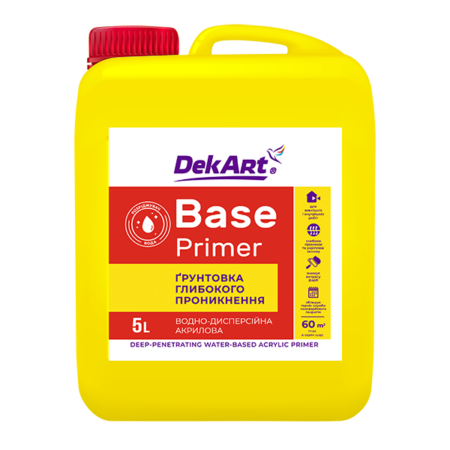
DekArt
Base
Deep penetrating primer
Specification
- it improves adhesion of building materials to the base layers
- deeply penetrates and hardens surfaces, indures life period of complex paint coat
- it lessens water absorption of the surfces (brick, concrete, slag block, sand-concrete mortar)
- decreases the consumption of paints.
Sphere of application
It is intended for deep penetrating and hardening of weak and fragile mineral surfaces (brick, concrete, slag block, cement and lime-cement mortars and other porous surfaces) before performing of different finishing works with plasters or putties, coating with waterborne paints, gluing of wallpapers and tile, setting of parquet and flooring.
Content
Technical data
| Consumption standard of 1 layer | 80-140 ml/m2, depending on the condition and structure of the surface. |
| Thinner | Water |
| Application | Apply with a roller, a brush or a spraying gun. |
| Drying period (23 °С, 50% RH) | ab. 1 hour. Drying period increases if the temperature is getting down and relative air humidity is increasing. |
| Solids content (DSTU ISO 3251) | ab. 1 % |
| Density (DSTU ISO 2811-1) | ab. 1 g/сm3 |
| VOC content (ISO 11890) | - |
| Warranty period | 12 months from manufacturing date, (at the temperature from +5 °С till +35 °С) |
| Packaging | 2 L, 5 L, 10 L |
Color
Application instruction
-
1. Surface preparation
The surface shall be dry, hard, without substantive damages and clean from chalk and chalk-lime coats, oily, bitumen and other dirt.
Existing efflorescences, loose and dirty areas shall be treated with a wire brush (metal scratcher) or in a mechanical way without wet treating of the surface.
2. Priming
The primer shall be applied evenly on the surface with a brush, a roller, or a spraying gun. Priming is performed at the temperature from + 10 °С till + 30 °С and relative air humidity no more than 80%. Extremely absorbing surfaces shall be treated in 2 layers with an intermediate drying period of 1 hour.
The application rate of 1 layer of the primer is from 80 ml/m2 to 140 ml/m2 depending on the condition and surface structure.
Do not prime the surface under direct sunlight, strong wind, frost and atmospheric precipitation. When the priming is applied it shall not be affected by atmospheric precipitation and sub-zero temperatures.
The next work can provide no earlier than 4 hours after the last layer coating.
3. Tool cleaning
Clean tools with water after application. Do not let them dry.
Primers for mineral surfaces DekArt
Primers for mineral surfacesповністю
Flow calculator
Consumption standard of 1 layer
When calculating the area to be painted, you need to subtract the area that will not be painted. (windows, doors, etc.)
Paint consumption may vary depending on dilution and uniformity of application of the paint.